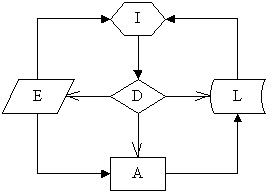![]()
![]()
Iterative Dialectic Engine for Automated Learning
IDEAL is the result of much thought on a variety of subjects over many years. Since 1995 these thoughts have been written down in order to engage the process of iterative development. To date this has resulted in 7 kg handwritten notes and IDEAL. The main themes of this research are:
This research establishes the following conditions for any design of an automated learning engine:
It must be based on the process of iterative development;
It must be able to distinguish general principles and particular instances, and it must be able to compare and correlate input data and stored data;
It must be able to reconcile opposing opinions or facts, by whatever means;
It must be able to manipulate an ensemble of scenarios generated using a toolbox of models;
It must be able to distinguish between data and control;
It must be able to express and record the relative importance of input data and stored data.
To design the automated learning engine we implement these conditions in a flowchart. Condition 5 calls for two types of connector:
|
|
Data connector. |
|
|
Control connector. |
Condition 2 calls for a distinction between general principles and particular instances. These comprise the stuff of algorithms and input/stored data devices respectively:
 |
Algorithm component. The configuration of connectors is based on the transistor (i.e. emitter, base and collector). |
| Evidence component, for input data. | |
| Log component, when storing data. | |
| Log component, when retrieving data. Note that, in this mode, L's functionality is identical to E's. |
Conditions 2 and 3 call for the comparison, correlation and reconciliation of data:
 |
Iteration component. Typically this flowchart symbol is used: (i) to indicate the start of an iteration loop; (ii) to define the initial parameter values for the iteration; (iii) to apply iteration completion conditions. The last of these functions involves data comparison, as required. |
Condition 4 calls for the facility to manipulate a number of scenarios and models. To do this, L must contain descriptions (e.g. source code) of all of the system algorithms, and there must be a central decision component. Condition 6 calls for the ability to modify input/stored data, which also requires a decision component (in addition to A, E and L, already defined):
| Decision component. |
Finally, Condition 1 calls for an implementation of the process of iterative development. The simplest iterative configuration involving all of the required components is IDEAL:

Q.E.D.
The Activist: "Very interesting... but What next for IDEAL?"
Click here to return to contents page
Copyright © Roger Kingdon 2004